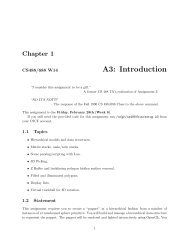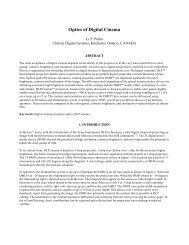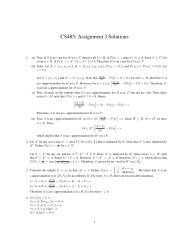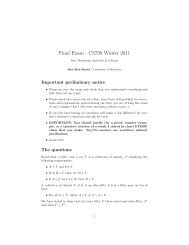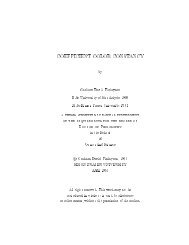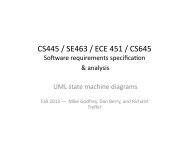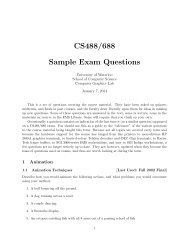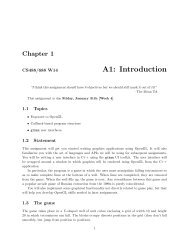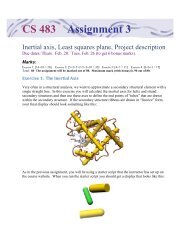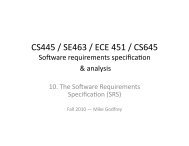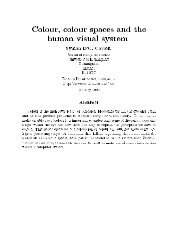Assignment 3 description. - Student.cs.uwaterloo.ca
Assignment 3 description. - Student.cs.uwaterloo.ca
Assignment 3 description. - Student.cs.uwaterloo.ca
Create successful ePaper yourself
Turn your PDF publications into a flip-book with our unique Google optimized e-Paper software.
CS350 Operating Systems Spring 2011<br />
1 Introduction<br />
<strong>Assignment</strong> Three<br />
OS/161 has a very simple virtual memory (VM) system, <strong>ca</strong>lled dumbvm. <strong>Assignment</strong> 3 is to replace dumbvm<br />
with a new virtual memory system that relaxes some, but not all, of dumbvm’s limitations. Your new system<br />
will implement a replacement policy for the TLB, so that the kernel will not crash if the TLB fills up. It<br />
will also implement on-demand loading of pages. This will allow programs that have address spaces larger<br />
than physi<strong>ca</strong>l memory to run, provided that they do not touch more pages than will fit in physi<strong>ca</strong>l memory.<br />
The last part is optional. You <strong>ca</strong>n make your new system <strong>ca</strong>pable of re-using the physi<strong>ca</strong>l memory that<br />
is freed up when a process terminates or a kernel data structure is de-allo<strong>ca</strong>ted.<br />
2 Code Review<br />
As was the <strong>ca</strong>se for the first OS/161 assignment, you should begin with a <strong>ca</strong>reful review of the existing<br />
OS/161 code with which you will be working. The rest of this section of the assignment identifies some<br />
important files for you to consider. There are no code reading questions to be answered for <strong>Assignment</strong> 3.<br />
Nonetheless, it is important for you to understand these files.<br />
In kern/vm<br />
The machine-independent part of your virtual memory implementation should go in this directory. Currently,<br />
the only file here is addrspace.c, which contains stub implementations of several of the functions that you<br />
will need to implement. You may wish to add additional files in this directory.<br />
In kern/userprog<br />
loadelf.c: This file contains the functions responsible for loading an ELF executable from the filesystem<br />
into virtual memory space. You should already be familiar with this file from <strong>Assignment</strong> 2. Since you<br />
will be implementing on-demand page loading in <strong>Assignment</strong> 3, you will need to change the behaviour<br />
that is implemented here.<br />
In kern/include<br />
addrspace.h: Defines the addrspace interface. You will need to make changes here, at least to define an<br />
appropriate addrspace structure.<br />
vm.h: Some VM-related definitions, including prototypes for some key functions, such as vm fault (the<br />
TLB miss handler) and alloc kpages (used, among other places, in kmalloc).<br />
In kern/arch/mips/mips<br />
dumbvm.c: This file is not used at all in <strong>Assignment</strong> 3. However, you <strong>ca</strong>n use the code here as a starting<br />
place for your <strong>Assignment</strong> 3 work. This code also includes examples of how to do things like manipulate<br />
the TLB.<br />
In kern/arch/mips/include<br />
In this directory, the file tlb.h defines the functions that are used to manipulate the TLB. In addition,<br />
vm.h includes some macros and constants related to address translation on the MIPS. Note that this vm.h<br />
is different from the vm.h in kern/include.<br />
1
You will have to understand the following files for the optional part.<br />
In kern/lib<br />
kheap.c: This file contains kernel’s implementations of kmalloc and kfree, to support dynamic memory<br />
allo<strong>ca</strong>tion. It should not be necessary for you to change the code in this file, but you do need to<br />
understand how the kernel’s dynamic memory allo<strong>ca</strong>tion works so that your physi<strong>ca</strong>l memory manager<br />
will interact properly with it.<br />
In kern/arch/mips/mips<br />
ram.c: This file includes functions that the kernel uses to manage physi<strong>ca</strong>l memory (RAM) while the kernel<br />
is booting up, before the VM system has been initialized. Since your VM system will essentially be<br />
taking over management of physi<strong>ca</strong>l memory, you need to understand how these functions work.<br />
3 Implementation Requirements<br />
All code changes for this assignment should be enclosed in #if OPT A3 statements, as you have done with<br />
OPT A2 and OPT A1 in the previous assignments. For this to work, you must add #include "opt-A3.h" at<br />
the top of any file for which you make changes for this assignment.<br />
By default, any code changes that you made for <strong>Assignment</strong>s 1 and 2 will be included in your build when<br />
you compile for <strong>Assignment</strong> 3.<br />
3.1 TLB Management<br />
In the System/161 machine, each TLB entry includes a 20-bit virtual page number and a 20-bit physi<strong>ca</strong>l<br />
page number as well as the following five fields:<br />
global (1 bit): If set, ignore the pid bits in the TLB.<br />
valid (1 bit): When the valid bit is set, the TLB entry is supposed to contain a valid translation. This<br />
implies that the virtual page is present in physi<strong>ca</strong>l memory. A TLB miss exception (EX TLBL or<br />
EX TLBS) occurs when no valid TLB entry that maps the required virtual page is present in the TLB.<br />
dirty (1 bit): In class, we used the term “dirty bit” to refer to a bit that is set by the MMU to indi<strong>ca</strong>te<br />
that a page has been modified. OS/161’s “dirty” bit is not like this - it indi<strong>ca</strong>tes whether it is possible<br />
to modify a particular page. OS/161 <strong>ca</strong>n clear this bit to indi<strong>ca</strong>te that a page is read-only, and to force<br />
the MMU to generate an EX MOD exception if there is an attempt to write to the page.<br />
no<strong>ca</strong>che (1 bit): Unused in System/161. In a real processor, indi<strong>ca</strong>tes that the hardware <strong>ca</strong>che will be<br />
disabled when accessing this page.<br />
pid (6 bits): A context or address space ID that <strong>ca</strong>n be used to allow entries to remain in the TLB after<br />
a context switch.<br />
In OS/161, the global and pid fields are unused. This means that all of the valid entries in the TLB should<br />
describe pages in the address space of the currently running process, and the contents of the TLB should<br />
be invalidated when there is a context switch. In the dumbvm system, TLB invalidation is accomplished<br />
by the as activate function, which invalidates all of the TLB entries. OS/161’s context switch code <strong>ca</strong>lls<br />
as activate after every context switch (as long newly-running thread has an address space). If you preserve<br />
this functionality in as activate in your new VM system, you will have taken <strong>ca</strong>re of TLB invalidation.<br />
For this assignment, you are expected to write code to manage the TLB. When a TLB miss occurs,<br />
OS/161’s exception handler should load an appropriate entry into the TLB. If there is a free slot in the TLB,<br />
the new entry should go into the free slot. Otherwise, OS/161 should choose a TLB entry to evict, and evict<br />
it to make room for the new entry. You should implement a very simple first-in-first-out replacement policy<br />
for the TLB. As described above, OS/161 should also take <strong>ca</strong>re to ensure that all TLB entries refer to the<br />
currently running process.<br />
2
3.2 Read-Only Text Segment<br />
In the dumbvm system, all three address space segments (text, data, and stack) are both readable and<br />
writable by the appli<strong>ca</strong>tion. For this assignment, you should change this so that each appli<strong>ca</strong>tion’s text<br />
segment is read-only. Your kernel should set up TLB entries so that any attempt by an appli<strong>ca</strong>tion to<br />
modify its text section will <strong>ca</strong>use the MIPS MMU to generate a read-only memory exception (EX MOD).<br />
If such an exception occurs, your kernel should terminate the process that attempted to modify its text<br />
segment. Your kernel should not crash.<br />
3.3 On-Demand Page Loading<br />
Currently, when OS/161 loads a new program into an address space using runprogram (and, presumably, in<br />
your implementation of execv from <strong>Assignment</strong> 2), it pre-allo<strong>ca</strong>tes physi<strong>ca</strong>l frames for all of the program’s<br />
virtual pages, and it pre-loads all of the pages into physi<strong>ca</strong>l memory.<br />
For this assignment, you are required to change this so that physi<strong>ca</strong>l frames are allo<strong>ca</strong>ted on-demand and<br />
virtual pages are loaded on demand. “On-demand” means that that the page should be loaded (and physi<strong>ca</strong>l<br />
space should be allo<strong>ca</strong>ted for it) the first time that the appli<strong>ca</strong>tion tries to use (read or write) that page.<br />
Pages that are never used by an appli<strong>ca</strong>tion should never be loaded into memory, and should not consume a<br />
physi<strong>ca</strong>l frame.<br />
In order to do this, your kernel will need to have some means of keeping track of which parts of physi<strong>ca</strong>l<br />
memory are in use, and which parts <strong>ca</strong>n be allo<strong>ca</strong>ted to hold newly-loaded virtual pages. Your kernel will<br />
also need a way to keep track of which pages from each virtual address space have been loaded into physi<strong>ca</strong>l<br />
memory, and where in physi<strong>ca</strong>l memory they have been loaded.<br />
Since a program’s pages will not be pre-loaded into physi<strong>ca</strong>l memory when the program starts running,<br />
and since the TLB only maps pages that are in memory, the program will generate TLB miss exceptions<br />
as it tries to access its virtual pages. Here some things that the OS/161 kernel must do when the MMU<br />
generates a TLB miss exception for a particular page:<br />
• Determine whether the page is already in memory.<br />
• If it is already in memory, load an appropriate entry into the TLB (replacing an existing TLB entry if<br />
necessary) and then return from the exception.<br />
• If it is not already in memory, then<br />
– Allo<strong>ca</strong>te a place in physi<strong>ca</strong>l memory to store the page<br />
– Load the page, using information from the program’s ELF file to do so<br />
– Update OS/161’s information about this address space.<br />
– Load an appropriate entry into the TLB (replacing an existing TLB entry if necessary), and return<br />
from the exception.<br />
You are not required to implement page replacement for this assignment. Be<strong>ca</strong>use you will not implement<br />
page replacement, you will not be able to run appli<strong>ca</strong>tions that touch more pages than will fit into physi<strong>ca</strong>l<br />
memory. However, you should be able to run programs with virtual address spaces larger than physi<strong>ca</strong>l<br />
memory, provided that those programs do not touch more pages than will fit.<br />
3.4 Instrumentation<br />
You are required to add instrumentation to your kernel to collect and display some statisti<strong>cs</strong> related to<br />
virtual memory activity. You are required to collect the following statisti<strong>cs</strong>:<br />
TLB Faults: The number of TLB misses that have occurred<br />
TLB Faults with Free: The number of TLB misses for which there was free space in the TLB to add the<br />
new TLB entry.<br />
3
TLB Faults with Replace: The number of TLB misses for which there was no free space for the new<br />
TLB entry, and replacement was required.<br />
TLB Invalidations: The number of times the TLB was invalidated.<br />
TLB Reloads: The number of TLB misses for pages that were already in memory.<br />
Page Faults (Disk): The number of TLB misses that required a page to be loaded from disk.<br />
Page Faults (Zeroed): The number of TLB misses that required a new page to be zero-filled.<br />
Note that the sum of “TLB Faults with Free” and “TLB Faults with Replace” should be equal to “TLB<br />
Faults”. Also, the sum of ”TLB Reloads”, “Page Faults (Disk)”, and “Page Faults (Zeroed)” should also be<br />
equal to “TLB Faults”.<br />
When it is shut down (e.g., in vm shutdown), your kernel should display the statisti<strong>cs</strong> it has gathered.<br />
The display should look approximately like the example below. In particular, each line of output should<br />
begin with the characters “VMSTAT” so that we <strong>ca</strong>n easily identify them.<br />
Shutting down.<br />
VMSTAT TLB Faults = 470<br />
VMSTAT TLB Faults with Free = 470<br />
VMSTAT TLB Faults with Replace = 0<br />
VMSTAT TLB Invalidations = 277<br />
VMSTAT TLB Reloads = 466<br />
VMSTAT Page Faults (Disk) = 3<br />
VMSTAT Page Faults (Zeroed) = 1<br />
The system is halted.<br />
sys161: 278170480 cycles (41840449k, 299023u, 236031008i)<br />
sys161: 10216 irqs 8610 exns 0r/0w disk 18r/9181w console 7r/0w/5m emufs 0r/0w net<br />
sys161: Elapsed real time: 11.156885 seconds (24.9326 mhz)<br />
sys161: Elapsed virtual time: 11.126819200 seconds (25 mhz)<br />
3.5 Physi<strong>ca</strong>l Memory Management (Optional)<br />
This part is optional and you <strong>ca</strong>n implement it for extra credit. There is also a related set of design questions<br />
in Section 6.<br />
The dumbvm system does not provide any way to re-use physi<strong>ca</strong>l memory. Once physi<strong>ca</strong>l memory has<br />
been allo<strong>ca</strong>ted, there is no way to free it when it is no longer needed. As a result, the kernel will quickly run<br />
out of physi<strong>ca</strong>l memory.<br />
Your VM system must manage physi<strong>ca</strong>l memory so that it <strong>ca</strong>n be re-used. In particular, when a process<br />
terminates, any physi<strong>ca</strong>l frames that were used to hold that process’ pages should be freed, and they should<br />
be available for use to hold pages from other processes. This will require your kernel to provide some<br />
mechanism for keeping track of which frames are free and which have been allo<strong>ca</strong>ted.<br />
Your physi<strong>ca</strong>l memory manager should also support dynamic memory allo<strong>ca</strong>tion of kernel data structures,<br />
via kmalloc and kfree. The simplest way to do this is to change the implementations of the functions<br />
alloc kpages and free kpages. alloc kpages is <strong>ca</strong>lled by kmalloc when it needs additional pages (i.e.,<br />
frames) of physi<strong>ca</strong>l memory to manage. Similarly, free kpages is <strong>ca</strong>lled by kfree if there are frames that<br />
it no longer requires. You should modify alloc kpages to obtain the frames it needs from your physi<strong>ca</strong>l<br />
memory manager. Similarly, free kpages should return freed frames to your physi<strong>ca</strong>l memory manager so<br />
that it <strong>ca</strong>n re-use them for other purposes.<br />
Note that some of the physi<strong>ca</strong>l memory of the machine is used to hold the kernel’s code and data.<br />
In addition, when the kernel is booting - and before your VM system has been initialized - the kernel<br />
will dynami<strong>ca</strong>lly allo<strong>ca</strong>te additional memory for its data structures. OS/161 has a simple physi<strong>ca</strong>l memory<br />
allo<strong>ca</strong>tion mechanism (in arch/mips/mips/ram.c) which will support these early memory allo<strong>ca</strong>tions. When<br />
you initialize your VM system, you will need to make sure that it is aware of which parts of physi<strong>ca</strong>l memory<br />
4
are already being used by the kernel, so that it does not mistakenly allo<strong>ca</strong>te them for some other purpose.<br />
Your VM system is not required to re-use any parts of physi<strong>ca</strong>l memory that are allo<strong>ca</strong>ted to the kernel before<br />
your VM system is initialized - though it is OK for it to do so, provided that the kernel frees up the space.<br />
Once your VM system has been initialized, all subsequent physi<strong>ca</strong>l memory requests (via alloc kpages and<br />
free kpages from the kernel should be handled by your VM system.<br />
4 Configuring and Building<br />
Before you do any coding for <strong>Assignment</strong> 3, you will need to reconfigure your kernel for this assignment.<br />
Follow the same procedure that you used to configure for the first two assignments, but use the ASST3<br />
configuration file instead:<br />
% cd <strong>cs</strong>350-os161/os161-1.11/kern/conf<br />
% ./config ASST3<br />
% cd ../compile/ASST3<br />
% make depend<br />
% make<br />
% make install<br />
Warning: Once you reconfigure your kernel for <strong>Assignment</strong> 3, it will probably not compile.<br />
Even if it does compile, it will no longer work. This is normal. It happens be<strong>ca</strong>use your kernel<br />
relied, for <strong>Assignment</strong>s 1 and 2, on the dumbvm virtual memory implementation. Starting with <strong>Assignment</strong><br />
3, the dumbvm implementation is no longer configured to be part of your kernel, i.e., it is ignored. For this<br />
assignment, you will be re-implementing the functions that were formerly implemented by dumbvm. Until<br />
you do that, anything that relied on dumbvm (which means most of your kernel) will not work<br />
5 Where to Start<br />
You should start your work on this assignment by studying and understanding how the dumbvm implementation<br />
works. Also have a look at the addrspace stubs, and think about what changes you will need to make<br />
to dumbvm to meet the requirements for this assignment.<br />
Your initial focus should be on getting your kernel back to a state in which you <strong>ca</strong>n run a single simple<br />
program (e.g., palin) from the kernel command menu.<br />
Once this is done, we recommend that you implement the various parts of the assignment in the following<br />
order:<br />
1. TLB Management<br />
2. Instrumentation<br />
3. Read-Only Text Segment<br />
4. On-Demand Page Loading<br />
5. Physi<strong>ca</strong>l Memory Management<br />
The last two parts (on-demand loading and physi<strong>ca</strong>l memory management) are relatively independent and<br />
<strong>ca</strong>n be implemented in either order. However, remember that physi<strong>ca</strong>l memory management is optional.<br />
Some of our testing will be based on the statisti<strong>cs</strong> that are produced by your instrumentation, so you<br />
should definitely get that working before you start work on the last two parts of the assignment.<br />
6 Design Questions<br />
You are expected to prepare a short answers to the following questions about your work on A3.<br />
5
Question 1: Briefly describe the data structure(s) that your kernel uses to describe the virtual address<br />
space of each process. What information is recorded about each address space?<br />
Question 2: When your OS/161 handles a TLB miss, how does it determine whether the required page is<br />
already loaded into memory?<br />
Question 3: If, on a TLB miss, OS/161 determines that the required page is not in memory, how does it<br />
determine where to find the page?<br />
Question 4: How does your kernel ensure that read-only address space pages are not modified?<br />
If portions of your design are not implemented, you may nonetheless receive some credit for well thoughtout<br />
answers to these questions. However, if your implementation does not match your answers, your<br />
document must clearly indi<strong>ca</strong>te which parts of the design are not implemented, or are not<br />
implemented as described in your answers. Submission of answers that do not match the<br />
submitted implementation (and which do not flag any such differences) will be considered an<br />
act of a<strong>ca</strong>demic dishonesty.<br />
Following are the design questions for the optional part. However, unlike the required part, you have to<br />
implement the optional part in order to receive any credit for the optional design questions.<br />
Question 5: Briefly describe the data structure(s) that your kernel uses to manage the allo<strong>ca</strong>tion of physi<strong>ca</strong>l<br />
memory. What information is recorded in this data structure? When your VM system is initialized,<br />
how is the information in this data structure initialized?<br />
Question 6: When a single physi<strong>ca</strong>l frame needs to be allo<strong>ca</strong>ted, how does your kernel use the above data<br />
structure to choose a frame to allo<strong>ca</strong>te? When a physi<strong>ca</strong>l frame is freed, how does your kernel update<br />
the above data structure to support this?<br />
Question 7: Does your physi<strong>ca</strong>l memory system have to handle requests to allo<strong>ca</strong>te/free multiple (physi<strong>ca</strong>lly)<br />
contiguous frames? Under what circumstances? How does your physi<strong>ca</strong>l memory manager<br />
support this?<br />
Question 8: Are there any synchronization issues that arise when the above data structures are used? Why<br />
or why not?<br />
Please prepare your design question answers as a PDF file <strong>ca</strong>lled design3.pdf. Your design document<br />
should be at most two pages long using 1 inch margins and a minimum font size of 11 points.<br />
7 What to Submit<br />
You should submit your kernel source code and your design document using the <strong>cs</strong>350 submit command,<br />
as you did for the previous assignments. It is important that you use the <strong>cs</strong>350 submit command - do not<br />
use the regular submit command directly.<br />
Assuming that you followed the standard OS/161 setup instructions, your OS/161 source code will be<br />
lo<strong>ca</strong>ted in $HOME/<strong>cs</strong>350-os161/os161-1.11. To submit your work, you should<br />
1. place design3.pdf in the directory $HOME/<strong>cs</strong>350-os161/<br />
2. run /u/<strong>cs</strong>350/bin/<strong>cs</strong>350 submit in the directory $HOME/<strong>cs</strong>350-os161/<br />
This will package up your OS/161 kernel code and submit it, along with the PDF file, to the course account.<br />
Important: The <strong>cs</strong>350 submit script packages and submits everything under the os161-1.11/kern<br />
directory, except for the subtree os161-1.11/kern/compile. You are permitted to make changes to the<br />
OS/161 source code outside the kern subdirectory. For example, you might create a new test program under<br />
testbin. However, such changes will not be submitted when you run <strong>cs</strong>350 submit. Only your kernel code,<br />
under os161-1.11/kern, will be submitted.<br />
6



